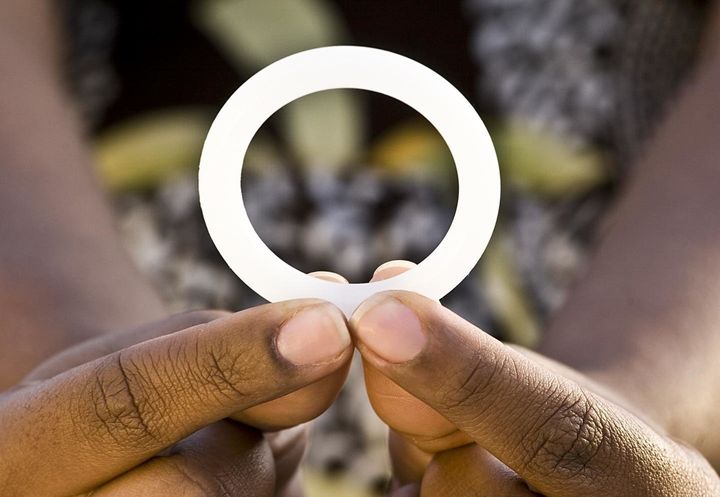
For instance, PReP, a daily pill designed to prevent the spread of HIV among high-risk groups, has demonstrated a 100 percent effectiveness rate among gay men in California. But past studies show that PReP isn't effective at all for African women -- not for biological reasons, but because there are social and cultural blocks that prevented these women from taking the pill every day.
Researchers hoped to offer better protection to women with the new vaginal ring, which is discrete, imperceptible to the male partner and only needs to be replaced once every four weeks. But a large multinational trial, published Monday in the New England Journal of Medicine, concluded that the ring has an effectiveness rate of just 27 percent overall.
When researchers looked at the data a second time and excluded non-complying participants and the youngest group of women (between 18 and 24 years old), the ring's effectiveness rating rose to 61 percent -- a much more promising level of prevention.
The ring shows that researchers still have a lot to learn about the kind of HIV prevention that disenfranchised, high-risk African women, who may not have complete control over their own bodies or medical decisions, can use effectively.
The ASPIRE Study
The big international study on the ring, dubbed the ASPIRE study, began in 2012 and enrolled more than 2,600 HIV-free women ages 18 to 45 across 15 sites in Malawi, South Africa, Uganda and Zimbabwe. These women were selected at random to receive either a ring containing the antiviral drug dapivirine or a placebo ring, although the women didn’t know which one they had received. The rings were replaced in the vagina once every four weeks. The women all received free condoms, information about HIV prevention services, treatment for sexually transmitted infections, counseling for HIV-risk reduction and partner testing.
On average, the ring provided a modest amount of protection of 27 percent. But once experts drilled further into the data, they found more heartening results: When scientists excluded data from two study sites after they found that the participants there weren’t using the ring consistently or returning for follow up study visits, the effectiveness ratio went up to 37 percent. And when they excluded women younger than 25 years old, the reduced risk went up to 61 percent. By contrast, the vaginal ring had zero protective effect on women ages 18 to 21.
The U.S. National Institutes of Health’s National Institute of Allergy and Infectious Diseases funded the trial as part of its mission to improve global health and protect Americans from disease. The agency's director, Dr. Anthony Fauci, described the study’s results as a “glass half-empty, glass half-full situation,” both because of the modest overall effectiveness of the ring for all women and because of the zero percent effectiveness among the youngest women -- a finding he said was “disturbing.”
The researchers believe older women were more successful because they were able to use the device more consistently, but they want to look further into this group to see if another, possibly biological reason could also account for the age-based discrepancy. Indeed, a statement about the study notes that levels of dapivirine in the younger women's blood were lower than expected. This could indicate either that the young women weren't using the ring as much, or that the medicine didn't remain in their bodies as intended.
Fauci said the research team’s next goal will be to determine what caused the age discrepancy. The ASPIRE study's findings align slightly with another depivirine ring study that found an overall risk reduction of 31 percent, with slightly higher effectiveness rates for women over 21 years old.
"When you look at the [totality] of the study, the efficacy was modest at best,” Fauci said. "We would have liked to have seen better results, but since we didn't see results as good as we wanted, particularly in the younger women, the next step is to try to figure out why that happens."
The ring is still a promising HIV prevention tool
Dr. Jeffrey Klausner, an HIV and infectious diseases expert at the UCLA School of Medicine and Public Health and the former director of the U.S. Centers for Disease Control and Prevention's HIV treatment program in South Africa, says ASPIRE's results are very exciting. He wasn't involved in the research, but reviewed the study and said that 61 percent effectiveness among women 25 years and older was a "powerful" effect, on par with the 60 percent effect male circumcision has on HIV prevention among heterosexual partners.
For comparison: Consistent condom use, which is the gold standard of HIV protection among the general public, protects a person from the virus 80 to 85 percent of the time.
He also underscored just how vital it is for women in certain parts of the world to have discrete methods of HIV prevention that they can control. The public health dream for HIV protection, Klausner said, would be a single dose vaccine a woman could get that wasn't dependent on her male partner's permission or payment. He called it the "ultimate win," but said this ring comes close in that women can go to a clinic, obtain the ring and use it without their partner's knowledge.
But Klausner still wants to know what the effectiveness rate of the vaginal ring would have been if a woman had used it perfectly. He said he looks forward to the release of more information about the data the ASPIRE study collected, especially on this point.
"Doctors want to know, if someone gets the medication, does it work, while public health people want to know, if I give it to 1,000 people, how well is it it going to work," he explained. "They’ve answered the second question before making it clear what the answer to the first question was, and that caused a lot of confusion."
Also on HuffPost:
